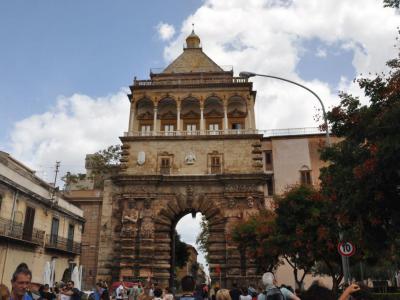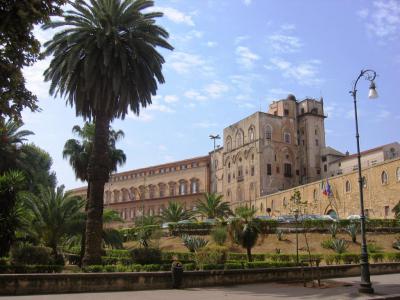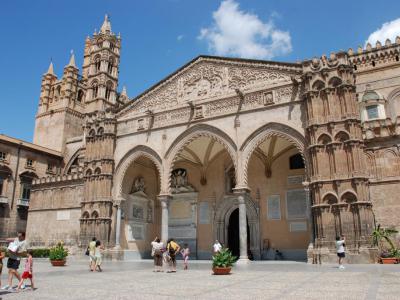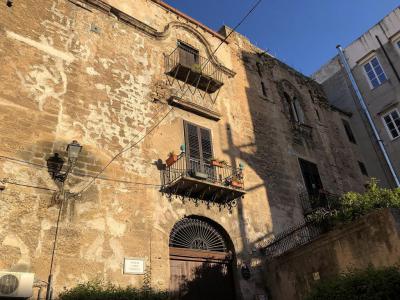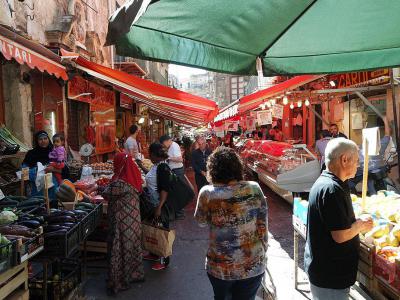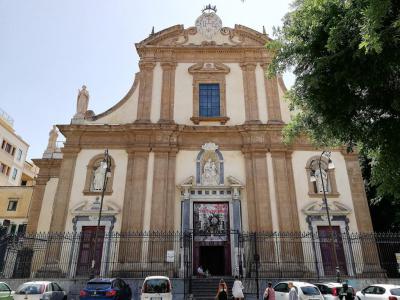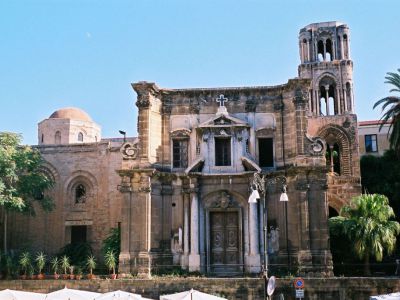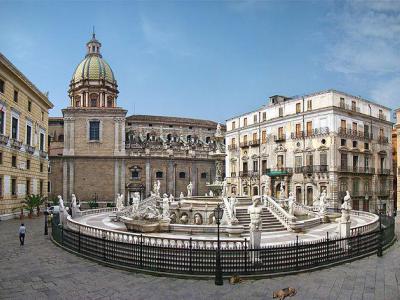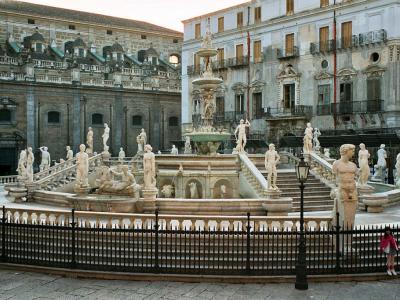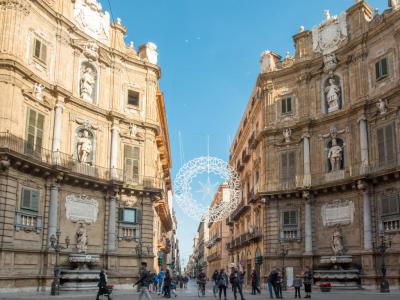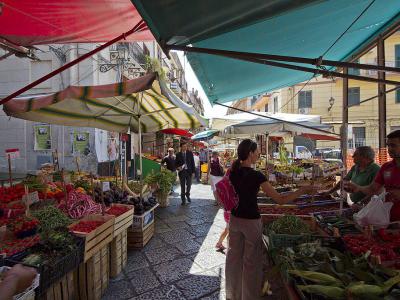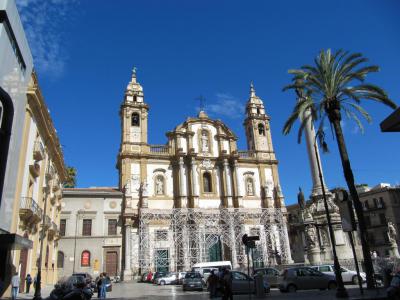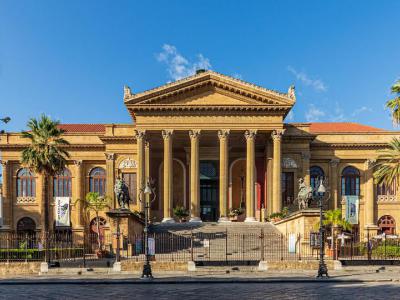Palermo Introduction Walking Tour (Self Guided), Palermo
Around 8,000 BC, people called Sicani drew pictures in a cave outside Palermo. The scene shows a ritual sacrifice in the theatre. Was it a paleolithic foreshadowing of the temples, churches, and cathedrals to come?
The Sicani were succeeded by the Phoenicians. They made a settlement called Ziz which eventually became Palermo. But first, the Greeks, followed by the Carthaginians, followed by the Romans, followed by the Germans, followed by Saracens, followed by Normans, had to leave their marks.
The Romans built temples, and the Saracens built mosques and libraries. In 1072 the Normans turned mosques into churches. In 1194 the Holy Roman Empire brought a spate of rebuilding. Baroque, Gothic, and other architectural styles emerged. Many of these buildings are preserved today.
The Norman Square, the seat of the Sicilian Regional Assembly, sits on the former residence of the Emir of Palermo. It houses the magnificent Palatine Chapel (1132), the family chapel of Roger II, King of Sicily.
The Byzantine Martorana Church, in central Palermo, sits on Bellini Square. San Domenico Church by the Rome Street is the "Pantheon of Illustrious Sicilians." The Church of Jesus (Gesu) of 1564 is built in the late-Renaissance style.
Monuments and squares crowd the list. Four Corners is an octagonal square framed by four buildings with nearly identical Baroque facades. The Town Hall sits on Pretoria Square, facing the notorious "Fountain of Shame." Above all, there is the Massimo Theatre, the opera house of Palermo, one of the largest in Europe.
In one of the most conquered cities in the world, there is no end of sights and experiences. Invasions, wars, and cultures of different races have left their marks in this always exciting, always surprising city.
The Sicani were succeeded by the Phoenicians. They made a settlement called Ziz which eventually became Palermo. But first, the Greeks, followed by the Carthaginians, followed by the Romans, followed by the Germans, followed by Saracens, followed by Normans, had to leave their marks.
The Romans built temples, and the Saracens built mosques and libraries. In 1072 the Normans turned mosques into churches. In 1194 the Holy Roman Empire brought a spate of rebuilding. Baroque, Gothic, and other architectural styles emerged. Many of these buildings are preserved today.
The Norman Square, the seat of the Sicilian Regional Assembly, sits on the former residence of the Emir of Palermo. It houses the magnificent Palatine Chapel (1132), the family chapel of Roger II, King of Sicily.
The Byzantine Martorana Church, in central Palermo, sits on Bellini Square. San Domenico Church by the Rome Street is the "Pantheon of Illustrious Sicilians." The Church of Jesus (Gesu) of 1564 is built in the late-Renaissance style.
Monuments and squares crowd the list. Four Corners is an octagonal square framed by four buildings with nearly identical Baroque facades. The Town Hall sits on Pretoria Square, facing the notorious "Fountain of Shame." Above all, there is the Massimo Theatre, the opera house of Palermo, one of the largest in Europe.
In one of the most conquered cities in the world, there is no end of sights and experiences. Invasions, wars, and cultures of different races have left their marks in this always exciting, always surprising city.
How it works: Download the app "GPSmyCity: Walks in 1K+ Cities" from Apple App Store or Google Play Store to your mobile phone or tablet. The app turns your mobile device into a personal tour guide and its built-in GPS navigation functions guide you from one tour stop to next. The app works offline, so no data plan is needed when traveling abroad.
Palermo Introduction Walking Tour Map
Guide Name: Palermo Introduction Walking Tour
Guide Location: Italy » Palermo (See other walking tours in Palermo)
Guide Type: Self-guided Walking Tour (Sightseeing)
# of Attractions: 13
Tour Duration: 2 Hour(s)
Travel Distance: 3.1 Km or 1.9 Miles
Author: Lilly
Sight(s) Featured in This Guide:
Guide Location: Italy » Palermo (See other walking tours in Palermo)
Guide Type: Self-guided Walking Tour (Sightseeing)
# of Attractions: 13
Tour Duration: 2 Hour(s)
Travel Distance: 3.1 Km or 1.9 Miles
Author: Lilly
Sight(s) Featured in This Guide:
- Porta Nuova (New Gate)
- Palazzo dei Normanni (Norman Palace)
- Palermo Cathedral
- Palazzo Conte Federico (Count Federic Palace)
- Mercato di Ballarò (Ballarò Market)
- Chiesa del Gesù (Church of Jesus)
- La Martorana (Martorana Church)
- Piazza Pretoria (Pretoria Square)
- Fontanna della Vergogna (Fountain of Shame)
- Quattro Canti (Four Corners Square)
- Mercato della Vucciria (Vucciria Market)
- Chiesa San Domenico (San Domenico Church)
- Teatro Massimo (Massimo Theater)
1) Porta Nuova (New Gate)
Charles V, Holy Roman Emperor, Archduke of Austria, King of Spain, Lord of the Netherlands, etc., etc., made so many journeys holding his empire together, he was never in one place for too long. Like a bee in a hothouse, he did a lot of pollinating. After conquering Tunis in 1535, he returned to Europe via Palermo, Sicily.
Charles entered Palermo passing through the Gate of the Eagle. The Senate of Palermo went wild. To memorialize the event, they authorized the building of a fancier gate. Marcantonio Colonna, Viceroy of Sicily, started construction in 1583. The gate was finished in 1584. He called it the Austrian Gate. The people called it the New Gate.
The gate burned down in 1667, so the Senate once again authorized building and they commissioned Gaspare Guercio to do the job. He finished the rebuilding in 1669.
The facade leading to the inner city and the Cassaro, the oldest street in Palermo, is formed like most triumphal arches. The facade leading outward to the Calatifimi Course and the Independence Square displays four large telamones in the forms of Moors captured by Charles V. Charles, who of course never got to see them.
Charles entered Palermo passing through the Gate of the Eagle. The Senate of Palermo went wild. To memorialize the event, they authorized the building of a fancier gate. Marcantonio Colonna, Viceroy of Sicily, started construction in 1583. The gate was finished in 1584. He called it the Austrian Gate. The people called it the New Gate.
The gate burned down in 1667, so the Senate once again authorized building and they commissioned Gaspare Guercio to do the job. He finished the rebuilding in 1669.
The facade leading to the inner city and the Cassaro, the oldest street in Palermo, is formed like most triumphal arches. The facade leading outward to the Calatifimi Course and the Independence Square displays four large telamones in the forms of Moors captured by Charles V. Charles, who of course never got to see them.
2) Palazzo dei Normanni (Norman Palace) (must see)
Sicily is a reef of survival in all the tsunamis of war and invasions that have washed over the island since ancient times. Successive invasions have ebbed away, leaving behind architecture, culture and DNA.
In the ninth century, on the highest point in the center of the old city, on top of Punic ruins, the Emir of Palermo built his Castle. Pieces of the Punic settlement and the Arab castle can be found under the foundations of the Norman Palace.
The Normans conquered Sicily in 1072, shortly after they had vanquished Saxon England. They established the County of Sicily with Palermo as the capital. They then gave the castle a complete do-over. It was to be the Royal Residence of the Norman kings.
The palace became a complex of buildings connected by arcades. The compound was established as a residence and administrative center wrapped in gardens. In 1132 King Roger II added the fabulous Palatine Chapel, the crown jewel of the Palace. It was consecrated in 1140. He wanted a family chapel.
In reality, the chapel is a three-story basilica. Dedicated to Saint Paul, it is a splendid example of the Arab-Norman-Byzantine architectural styles of 12th century Sicily. The dome, transept and apse are covered with Byzantine mosaics portraying "Christ Pantocrator", the Evangelists and scenes from the bible.
The Angevins, the Aragonese and the Swabians came and went. Spanish viceroys used the Palace as a military HQ. The Bourbons created the Red Room, the Yellow Room and the Green Room and redid the Hall of Hercules, known for its frescoes of Hercules. Then there are the Hall of the Viceroy, the Hall of the Winds and the Hall of Pompeii.
The Maqueda Courtyard and the Courtyard of the Fountain within the Palace are courtyards with three levels of Renaissance loggias and staircases. Of the original four towers, only two, the Pisan Tower and the Treasure Tower, remain.
The Palace is located at the Parlemento Square. The visitor entrance is at the Independence Square.
Why You Should Visit:
If you take in nothing else in Palermo, this is a must. Everything Sicilian is here, past and future.
In the ninth century, on the highest point in the center of the old city, on top of Punic ruins, the Emir of Palermo built his Castle. Pieces of the Punic settlement and the Arab castle can be found under the foundations of the Norman Palace.
The Normans conquered Sicily in 1072, shortly after they had vanquished Saxon England. They established the County of Sicily with Palermo as the capital. They then gave the castle a complete do-over. It was to be the Royal Residence of the Norman kings.
The palace became a complex of buildings connected by arcades. The compound was established as a residence and administrative center wrapped in gardens. In 1132 King Roger II added the fabulous Palatine Chapel, the crown jewel of the Palace. It was consecrated in 1140. He wanted a family chapel.
In reality, the chapel is a three-story basilica. Dedicated to Saint Paul, it is a splendid example of the Arab-Norman-Byzantine architectural styles of 12th century Sicily. The dome, transept and apse are covered with Byzantine mosaics portraying "Christ Pantocrator", the Evangelists and scenes from the bible.
The Angevins, the Aragonese and the Swabians came and went. Spanish viceroys used the Palace as a military HQ. The Bourbons created the Red Room, the Yellow Room and the Green Room and redid the Hall of Hercules, known for its frescoes of Hercules. Then there are the Hall of the Viceroy, the Hall of the Winds and the Hall of Pompeii.
The Maqueda Courtyard and the Courtyard of the Fountain within the Palace are courtyards with three levels of Renaissance loggias and staircases. Of the original four towers, only two, the Pisan Tower and the Treasure Tower, remain.
The Palace is located at the Parlemento Square. The visitor entrance is at the Independence Square.
Why You Should Visit:
If you take in nothing else in Palermo, this is a must. Everything Sicilian is here, past and future.
3) Palermo Cathedral (must see)
In 831 Arab conquerors noted the presence of a great "infidel temple" on the present-day site of Palermo Cathedral. They promptly turned the infidel temple into the Great Mosque. Then, in 1072, along came Roger I and the Normans and the Great Mosque turned back into a Christian church. Roger II was crowned in this early Palermo Cathedral.
The present Palermo Cathedral has a history of changes, additions and restorations that have given it a mixture of architectural styles. The cathedral was erected in 1185 by Walter Ophamil. Walter was the Anglo-Norman archbishop of Palermo and minister to King William II. Walter's remains currently lie in the Cathedral's crypt.
The entrance to the Cathedral is on the Matteo Bonello Street. The Gothic portal of the entrance is framed by two towers. Above the portal is a niche holding a 15th century Madonna. The broad Gothic portico of the main entrance is on the south side. It has turrets in a Gothic-Catalan style and three arcades, built in 1465.
The interior is planned as a Latin cross. There is a nave and two aisles separated by pilasters. The royal tombs are in chapels on the right.
The treasures of the cathedral are sacred vestments of the 16th and 18th centuries, monstrances, chalices, a breviary of 15th century miniatures and a gold tiara belonging to Constance of Aragon.
The present Palermo Cathedral has a history of changes, additions and restorations that have given it a mixture of architectural styles. The cathedral was erected in 1185 by Walter Ophamil. Walter was the Anglo-Norman archbishop of Palermo and minister to King William II. Walter's remains currently lie in the Cathedral's crypt.
The entrance to the Cathedral is on the Matteo Bonello Street. The Gothic portal of the entrance is framed by two towers. Above the portal is a niche holding a 15th century Madonna. The broad Gothic portico of the main entrance is on the south side. It has turrets in a Gothic-Catalan style and three arcades, built in 1465.
The interior is planned as a Latin cross. There is a nave and two aisles separated by pilasters. The royal tombs are in chapels on the right.
The treasures of the cathedral are sacred vestments of the 16th and 18th centuries, monstrances, chalices, a breviary of 15th century miniatures and a gold tiara belonging to Constance of Aragon.
4) Palazzo Conte Federico (Count Federic Palace) (must see)
Like to know how the upper 1% live in Sicily? You can be the guests of Count and Countess Federico and they will give you a tour of their ancient homestead.
The Conte Federico Palace is located between Biscottari Street and Conte Federico Square, a short walk from Palermo Cathedral. The palace is built over the remains of the Punic-Roman walls that once surrounded the city. Its 12th century Arab-Norman tower, Busuemi Tower, encapsulates the ancient Arab gateway, Bar el Soudan.
The Palace was acquired by the Federico counts in the 17th century. The counts bought the hospice of Busuemi Port from the Olivetan Fathers of Santa Maria della Spasimo. There is an internal courtyard with stone carvings by Giuseppe Venanzio Marvuglia. A red marble staircase leads to the main floor and halls decorated in different styles.
The halls have the original furnishings of the eras they represent. There are coffered ceilings of the 15th century, frescoes by Vito D'Anna of the 18th century, and several collections of weapons and ceramics. A must visit room is the dance gallery. The gallery holds a grand piano played by Wagner in 1882.
The Count and Countess will personally receive visitors. Look forward to an evening aperitif in the Arabic-Norman tower and a candle light dinner in the Baroque dance hall. Tours can be arranged for groups and the old kitchen is used for Sicilian cooking classes.
Sounds like a winner. Ciao!
The Conte Federico Palace is located between Biscottari Street and Conte Federico Square, a short walk from Palermo Cathedral. The palace is built over the remains of the Punic-Roman walls that once surrounded the city. Its 12th century Arab-Norman tower, Busuemi Tower, encapsulates the ancient Arab gateway, Bar el Soudan.
The Palace was acquired by the Federico counts in the 17th century. The counts bought the hospice of Busuemi Port from the Olivetan Fathers of Santa Maria della Spasimo. There is an internal courtyard with stone carvings by Giuseppe Venanzio Marvuglia. A red marble staircase leads to the main floor and halls decorated in different styles.
The halls have the original furnishings of the eras they represent. There are coffered ceilings of the 15th century, frescoes by Vito D'Anna of the 18th century, and several collections of weapons and ceramics. A must visit room is the dance gallery. The gallery holds a grand piano played by Wagner in 1882.
The Count and Countess will personally receive visitors. Look forward to an evening aperitif in the Arabic-Norman tower and a candle light dinner in the Baroque dance hall. Tours can be arranged for groups and the old kitchen is used for Sicilian cooking classes.
Sounds like a winner. Ciao!
5) Mercato di Ballarò (Ballarò Market)
Gaspare Palermo wrote a guide to Palermo in the 1800s. He describes the Piazza Ballaro as "a large square in the Albergheria district, oblong in shape and not very wide, ... paved with large flints." Ballaro is the oldest and largest market of its kind in the city. It reaches from Piazza Casa Professa to Tukory Course.
The market reminds one of an Arab souk in a Muslim town. The colors, smells, the stalls covering streets and squares, awnings, hanging baskets and the persistent calls of "abbanniata!" in the Palermo patois are living monuments to old Palermo. In this market one can buy almost anything but certainly fruit, vegetables, fish and meat.
The market in fact dates back to the era of Arab rule. The name Ballaro may come from the name Bahlara, a village near Monreale, a town south of Palermo. Or it may from Ag-Vallaraja, a region of India known for its spices. Or it might come from "Segeballarath", which means, simply, "fair market."
Ballaro has existed for centuries by the Church of the Carmelite Fathers. It is above all a "Piazza di Grascia", a place for food.
The market reminds one of an Arab souk in a Muslim town. The colors, smells, the stalls covering streets and squares, awnings, hanging baskets and the persistent calls of "abbanniata!" in the Palermo patois are living monuments to old Palermo. In this market one can buy almost anything but certainly fruit, vegetables, fish and meat.
The market in fact dates back to the era of Arab rule. The name Ballaro may come from the name Bahlara, a village near Monreale, a town south of Palermo. Or it may from Ag-Vallaraja, a region of India known for its spices. Or it might come from "Segeballarath", which means, simply, "fair market."
Ballaro has existed for centuries by the Church of the Carmelite Fathers. It is above all a "Piazza di Grascia", a place for food.
6) Chiesa del Gesù (Church of Jesus) (must see)
Jesuits arrived in Palermo in 1549. After settling in, they began to build. They had their own Jesuit architect, Giovanni Tristano. Following his design, they built one of the most important Baroque churches in Sicily, Church of Jesus.
Tristano's design required a single nave, transepts and side chapels. Early in the 17th century this was changed by architect Natale Masuccio. Natale favored something more sumptuous. He removed the chapel walls and added two more naves. When this was finished in 1636, the church was consecrated.
In 1943, during an air raid, a bomb exploded and crushed the church dome. The adjacent walls were mostly destroyed along with frescoes and paintings.
Some of the interior survived. Marble bas-reliefs showing the Adoration of the Shepards and the Adoration of the Magi by Gioacchino Vitagliano (1719-21) remain intact. A fresco of the Adoration of the Magi by Antonino Grano and a relief of the Glory of Saint Luke by Ignazio Marabitti also lived after the bomb.
The facade has three portals in the lower part. Above are niches with statues of Ignatius Loyola, a Madonna and Child and Francis Xavier. The nave is 237 feet long, 140 feet wide and 230 feet high. It is decorated with frescoes. The pillars are covered with marble reliefs and mosaics. The rebuilt church has a double dome.
Tristano's design required a single nave, transepts and side chapels. Early in the 17th century this was changed by architect Natale Masuccio. Natale favored something more sumptuous. He removed the chapel walls and added two more naves. When this was finished in 1636, the church was consecrated.
In 1943, during an air raid, a bomb exploded and crushed the church dome. The adjacent walls were mostly destroyed along with frescoes and paintings.
Some of the interior survived. Marble bas-reliefs showing the Adoration of the Shepards and the Adoration of the Magi by Gioacchino Vitagliano (1719-21) remain intact. A fresco of the Adoration of the Magi by Antonino Grano and a relief of the Glory of Saint Luke by Ignazio Marabitti also lived after the bomb.
The facade has three portals in the lower part. Above are niches with statues of Ignatius Loyola, a Madonna and Child and Francis Xavier. The nave is 237 feet long, 140 feet wide and 230 feet high. It is decorated with frescoes. The pillars are covered with marble reliefs and mosaics. The rebuilt church has a double dome.
7) La Martorana (Martorana Church) (must see)
La Martorana is also known as The Church of Saint Mary of the Admiral. The admiral was George of Antioch, a Syrian Christian and principal minister of King Roger II of Sicily. George was not only the King's main man, he founded this Eastern Orthodox church.
The charter is dated from 1143 and written in ancient Greek and Arabic. Construction may have started before 1143 but the church was finished definitely by 1151. George died that same year. He and his wife are buried in the narthex of the church.
In 1193 or so Lady Eloisa Martorana moved in next door with her own division of Benedictine nuns. She established her convent which eventually took over the church, thus giving it the name "la Martorana." The nuns of Martorana created sugary treats in the form of fruit. The nuns have left but the Martorana fruit is still popular today.
The church has undergone architectural changes since it was built. The narthex houses the tombs of George and his wife. The campanile, elaborately constructed with arches and loggias, still is used as the main entrance.
The church is famous for its interior. A series of Byzantine mosaics are similar to those in the Palatine Chapel and Cefalu Cathedral. Mosaics on the walls show Roger II receiving the crown of Sicily from none other than Jesus. The dome over the nave has Byzantine images of Christ Pantokrator with saints, prophets and evangelists.
The charter is dated from 1143 and written in ancient Greek and Arabic. Construction may have started before 1143 but the church was finished definitely by 1151. George died that same year. He and his wife are buried in the narthex of the church.
In 1193 or so Lady Eloisa Martorana moved in next door with her own division of Benedictine nuns. She established her convent which eventually took over the church, thus giving it the name "la Martorana." The nuns of Martorana created sugary treats in the form of fruit. The nuns have left but the Martorana fruit is still popular today.
The church has undergone architectural changes since it was built. The narthex houses the tombs of George and his wife. The campanile, elaborately constructed with arches and loggias, still is used as the main entrance.
The church is famous for its interior. A series of Byzantine mosaics are similar to those in the Palatine Chapel and Cefalu Cathedral. Mosaics on the walls show Roger II receiving the crown of Sicily from none other than Jesus. The dome over the nave has Byzantine images of Christ Pantokrator with saints, prophets and evangelists.
8) Piazza Pretoria (Pretoria Square)
In the exact center of historic Palermo is the Pretoria Square. In 1573 the senate of the city bought a fountain. Originally intended for a private garden in Florence, it was shipped piecemeal to Palermo. It didn't fit. Some buildings around the square were demolished to accommodate the fountain. There is little wiggle room left in the square.
Three sides of the square are enclosed by buildings. There is the Praetorian Palace (the town hall), which lends its name to the Square. It is also called the Palace of the Eagles. The palace was built between 1463 and 1478. It has a Renaissance Revival-Neoclassical appearance. It houses mayoral offices and weapons of the Napoleonic wars.
The Church of Saint Catherine borders the square and it is between the Pretoria Square and the Bellini Square. The appearance of the church is a mixture of Sicilian Baroque, Rococo and Renaissance elements. Two baronial manses also squeeze up to the square. They are the Bonocore Palce and Bordonarao Palace.
The remaining, fourth side of the square holds a descending staircase to Maqueda Street.
Three sides of the square are enclosed by buildings. There is the Praetorian Palace (the town hall), which lends its name to the Square. It is also called the Palace of the Eagles. The palace was built between 1463 and 1478. It has a Renaissance Revival-Neoclassical appearance. It houses mayoral offices and weapons of the Napoleonic wars.
The Church of Saint Catherine borders the square and it is between the Pretoria Square and the Bellini Square. The appearance of the church is a mixture of Sicilian Baroque, Rococo and Renaissance elements. Two baronial manses also squeeze up to the square. They are the Bonocore Palce and Bordonarao Palace.
The remaining, fourth side of the square holds a descending staircase to Maqueda Street.
9) Fontanna della Vergogna (Fountain of Shame) (must see)
This is the story of how the Fountain of Shame got its name. The fountain, a vast waterworks of a fountain populated by gods, demons, animals and wood sprites, was created as a garden folly for Luigi de Toledo in Florence in 1554. Luigi, brother of a former Viceroy of Sicily, Garcia de Toledo, became heavily in debt. So, he sold the fountain.
The fountain was the work of sculptor Francesco Camilliani, of Florence. It held 48 statues and a lot of plumbing. It required disassembling, shipping and reassembling. There was a chance of loss and damage. But the senate of Palermo didn't care. It was just the thing to plop down in front of the Pretorio Palace, the town hall.
The fountain was designed to be entered. An outer circle of stone guards a moat of water. This outer ring is joined to an inner ring by steps, allowing entrance to the center. The gods of old surround the visitor. Fantasy creatures abound in the rings, their open mouths spraying water.
In the 18th and 19th centuries the fountain was not fully appreciated. The nudity of the human figures did not go over as well as they might have in Florence. It is said nuns from a neighboring convent vandalized the nudes, breaking off some offending body parts. A more likely story is the Pretoria Palace had become the center of run-away corruption.
In any event the square and the fountain were respectively awarded the names Square and Fountain of Shame.
The fountain was the work of sculptor Francesco Camilliani, of Florence. It held 48 statues and a lot of plumbing. It required disassembling, shipping and reassembling. There was a chance of loss and damage. But the senate of Palermo didn't care. It was just the thing to plop down in front of the Pretorio Palace, the town hall.
The fountain was designed to be entered. An outer circle of stone guards a moat of water. This outer ring is joined to an inner ring by steps, allowing entrance to the center. The gods of old surround the visitor. Fantasy creatures abound in the rings, their open mouths spraying water.
In the 18th and 19th centuries the fountain was not fully appreciated. The nudity of the human figures did not go over as well as they might have in Florence. It is said nuns from a neighboring convent vandalized the nudes, breaking off some offending body parts. A more likely story is the Pretoria Palace had become the center of run-away corruption.
In any event the square and the fountain were respectively awarded the names Square and Fountain of Shame.
10) Quattro Canti (Four Corners Square) (must see)
Although it is commonly called Four Corners, the actual name of the square is Piazza Vigliena. It is named in honor of the Viceroy, Juan Fernandez Pacheco. The square is situated at the intersection of Maqueda Street and Vittorio Emanuele Street. Called a square, in olden times it was called "Octagon of the Sun." It is actually eight-sided.
The octagon is formed by four street sides and four building sides. The buildings are Baroque, of the same height and almost identical. The facades hold fountains (yes, fountains), statues of the four seasons, the four Spanish kings of Sicily and the four saintly patronesses of Palermo, Christina, Ninfa, Olivia, and Agata.
The facades are curved. They are four stories high. Fountains reach to the second floor. There are niches on the third and fourth floors holding statues. The rooftops are graced with coats-of-arms.
The square was laid out by order of the viceroys from 1608 to 1620. The architects were Giulio Lasso and Mariano Smiriglio.
The octagon is formed by four street sides and four building sides. The buildings are Baroque, of the same height and almost identical. The facades hold fountains (yes, fountains), statues of the four seasons, the four Spanish kings of Sicily and the four saintly patronesses of Palermo, Christina, Ninfa, Olivia, and Agata.
The facades are curved. They are four stories high. Fountains reach to the second floor. There are niches on the third and fourth floors holding statues. The rooftops are graced with coats-of-arms.
The square was laid out by order of the viceroys from 1608 to 1620. The architects were Giulio Lasso and Mariano Smiriglio.
11) Mercato della Vucciria (Vucciria Market)
Ok, what does "Vucciria" mean? There are theories. There is the French word "boucherie", butcher shop; yes, sounds like. Then there is a more likely source. The word "vucciria" in Palermo means confusion. In the big open-air market there are cries of the vendors, the "abbonnati" contending with a confusion of voices. It's very like an Arab market.
The market has been in operation one way or another since the 12th century. In 1783 the Viceroy Caracciolo made some changes. First he named the square after himself. Then he caused arcades to be built to house sales counters and he topped it off with a fountain in the middle.
Streets and alleys weave around the Vucciria. Stalls hold boxes full of lemons, fish, olives, tomatoes and other items for the Sicilian cuisine. The air is replete with tempting smells and colors.
Some buildings around the square have been restored recently and some stalls have closed or moved to other markets. The central area has been repaved. However, there are still fish stalls in the market and the fish must be continuously kept wet. When someone speaks of an event that will never happen they say, "When the floor of Vucciria dries up."
The market has been in operation one way or another since the 12th century. In 1783 the Viceroy Caracciolo made some changes. First he named the square after himself. Then he caused arcades to be built to house sales counters and he topped it off with a fountain in the middle.
Streets and alleys weave around the Vucciria. Stalls hold boxes full of lemons, fish, olives, tomatoes and other items for the Sicilian cuisine. The air is replete with tempting smells and colors.
Some buildings around the square have been restored recently and some stalls have closed or moved to other markets. The central area has been repaved. However, there are still fish stalls in the market and the fish must be continuously kept wet. When someone speaks of an event that will never happen they say, "When the floor of Vucciria dries up."
12) Chiesa San Domenico (San Domenico Church)
The church of San Domenico in Palermo is known locally as the "Pantheon of Illustrious Sicilians." It has overseen the burials of many prominent figures in Sicilian history. The first Dominican church here was Norman-Gothic in style. It was small, but it had a convent and cloister. It was made in imitation of the Benedictine cloister of Monreale.
In the 15th century the church had really become too small. With the aid of Pope Martin V a new church was built in the Renaissance style. Time marches on and the Renaissance church in turn became too small. In 1630 Domincans commissioned architect Andrea Cirrincione to build a replacement. It took a while.
It was not until 1640 that ground was broken. The work continued. The Baroque facade was finished in 1726 and the bell tower was completed in 1770.
The style is Baroque. There are two high bell towers and stucco statues on the facade of saints and popes, some in niches. There are twelve columns on the facade. They stand in twos. Eight line the entrance and four are on the bell towers.
The convent is accessible from the north side of the church. The cloister has columns and arches from the 13th century. On the walls are paintings of Dominican Saints, the Apocalypse and the Last judgement. There is also a refectory and a library.
In the 15th century the church had really become too small. With the aid of Pope Martin V a new church was built in the Renaissance style. Time marches on and the Renaissance church in turn became too small. In 1630 Domincans commissioned architect Andrea Cirrincione to build a replacement. It took a while.
It was not until 1640 that ground was broken. The work continued. The Baroque facade was finished in 1726 and the bell tower was completed in 1770.
The style is Baroque. There are two high bell towers and stucco statues on the facade of saints and popes, some in niches. There are twelve columns on the facade. They stand in twos. Eight line the entrance and four are on the bell towers.
The convent is accessible from the north side of the church. The cloister has columns and arches from the 13th century. On the walls are paintings of Dominican Saints, the Apocalypse and the Last judgement. There is also a refectory and a library.
13) Teatro Massimo (Massimo Theater) (must see)
The Massimo Theater is an opera house and company located on Verdi Square. It is the biggest opera house in Italy and the third largest in Europe.
The Palermo Council initiated an international competition to design and build an opera house in 1864. The idea was to promote the status of a new unified Italy. Giovan Basile designed the theater. After he died in 1891, the work was taken over by his son, Ernesto Basile.
Basile was a fan of classical Sicilian architecture. He used a neoclassical theme borrowed from the old Greek temples of Agrigento. He also used a late-Renaissance style. The auditorium seats almost 1,400 people. It has seven tiers of box seating. The stage is inclined and the seating rises up from the stage in a general horseshoe shape.
In 1974 the theater was closed for renovations. Costs, corruption and politics kept it closed for 23 years. The opera season opened again in 1998. Corruption and politics continue to disrupt the functioning of the house but new management promises to keep it on track.
The Palermo Council initiated an international competition to design and build an opera house in 1864. The idea was to promote the status of a new unified Italy. Giovan Basile designed the theater. After he died in 1891, the work was taken over by his son, Ernesto Basile.
Basile was a fan of classical Sicilian architecture. He used a neoclassical theme borrowed from the old Greek temples of Agrigento. He also used a late-Renaissance style. The auditorium seats almost 1,400 people. It has seven tiers of box seating. The stage is inclined and the seating rises up from the stage in a general horseshoe shape.
In 1974 the theater was closed for renovations. Costs, corruption and politics kept it closed for 23 years. The opera season opened again in 1998. Corruption and politics continue to disrupt the functioning of the house but new management promises to keep it on track.
Walking Tours in Palermo, Italy
Create Your Own Walk in Palermo
Creating your own self-guided walk in Palermo is easy and fun. Choose the city attractions that you want to see and a walk route map will be created just for you. You can even set your hotel as the start point of the walk.
Historical Religious Buildings
Religion has always played an important role in the lives of the Italians – and the Sicilians are no exception. Thus, it is little wonder that the main city of the island, Palermo, boasts a plethora of religious buildings. The collection of historical churches found here ranges from the Arab-Norman-Byzantine to the Medieval, Gothic, Baroque and the Renaissance.
In the course of history, many... view more
Tour Duration: 2 Hour(s)
Travel Distance: 3.2 Km or 2 Miles
In the course of history, many... view more
Tour Duration: 2 Hour(s)
Travel Distance: 3.2 Km or 2 Miles
Palaces of Palermo
For centuries, Sicilian capital Palermo has been a focal point for the construction of noble dwellings and palaces. The latter were and still are a fine manifestation of the historical life in the region. They are a few hundred of them still in place, ranging chronologically from the medieval period to the first decades of the 20th century, and comprising an impressive collection of architectural... view more
Tour Duration: 1 Hour(s)
Travel Distance: 2.6 Km or 1.6 Miles
Tour Duration: 1 Hour(s)
Travel Distance: 2.6 Km or 1.6 Miles
The Most Popular Cities
/ view all



